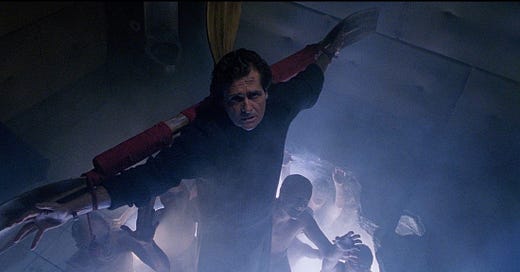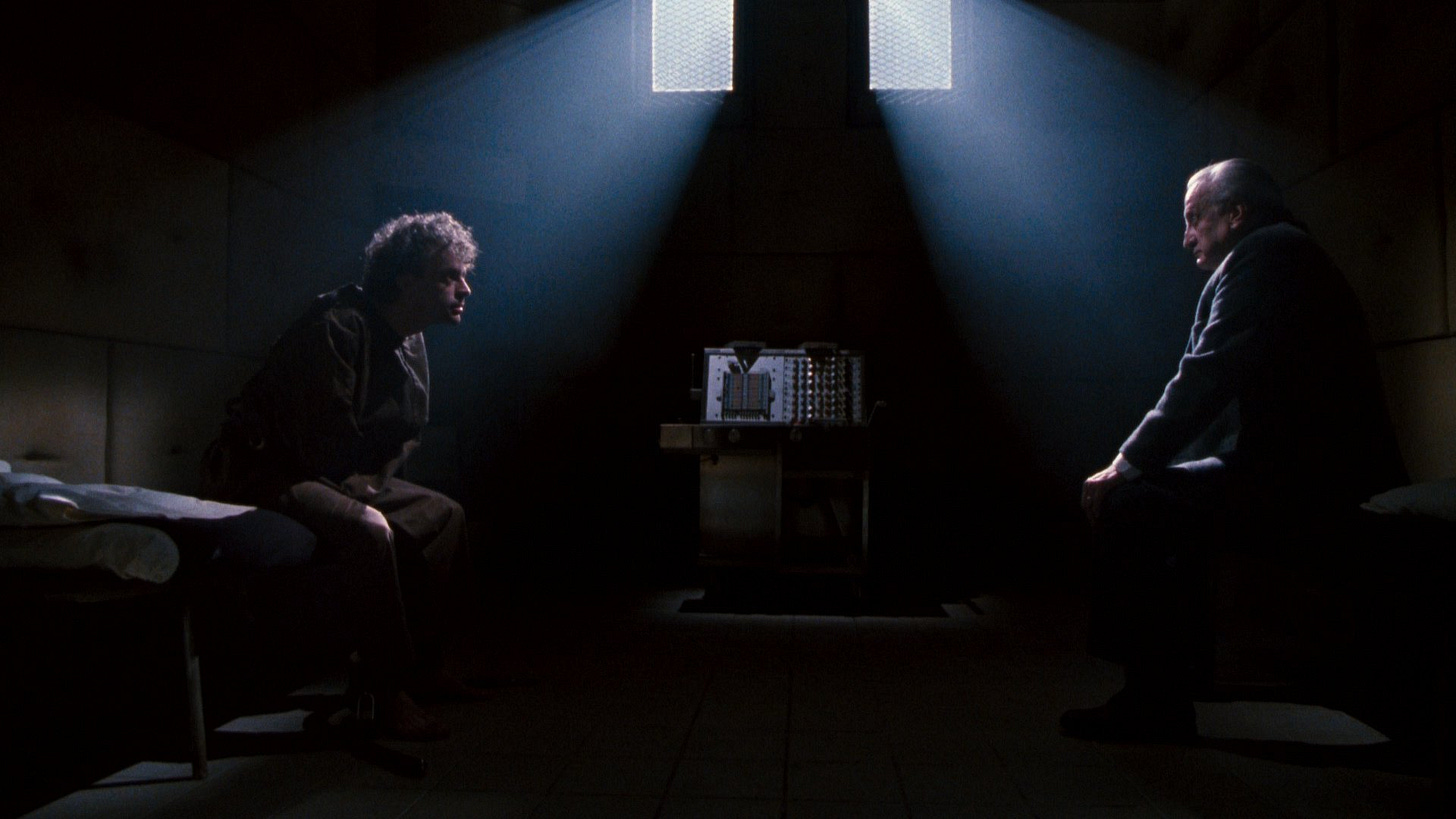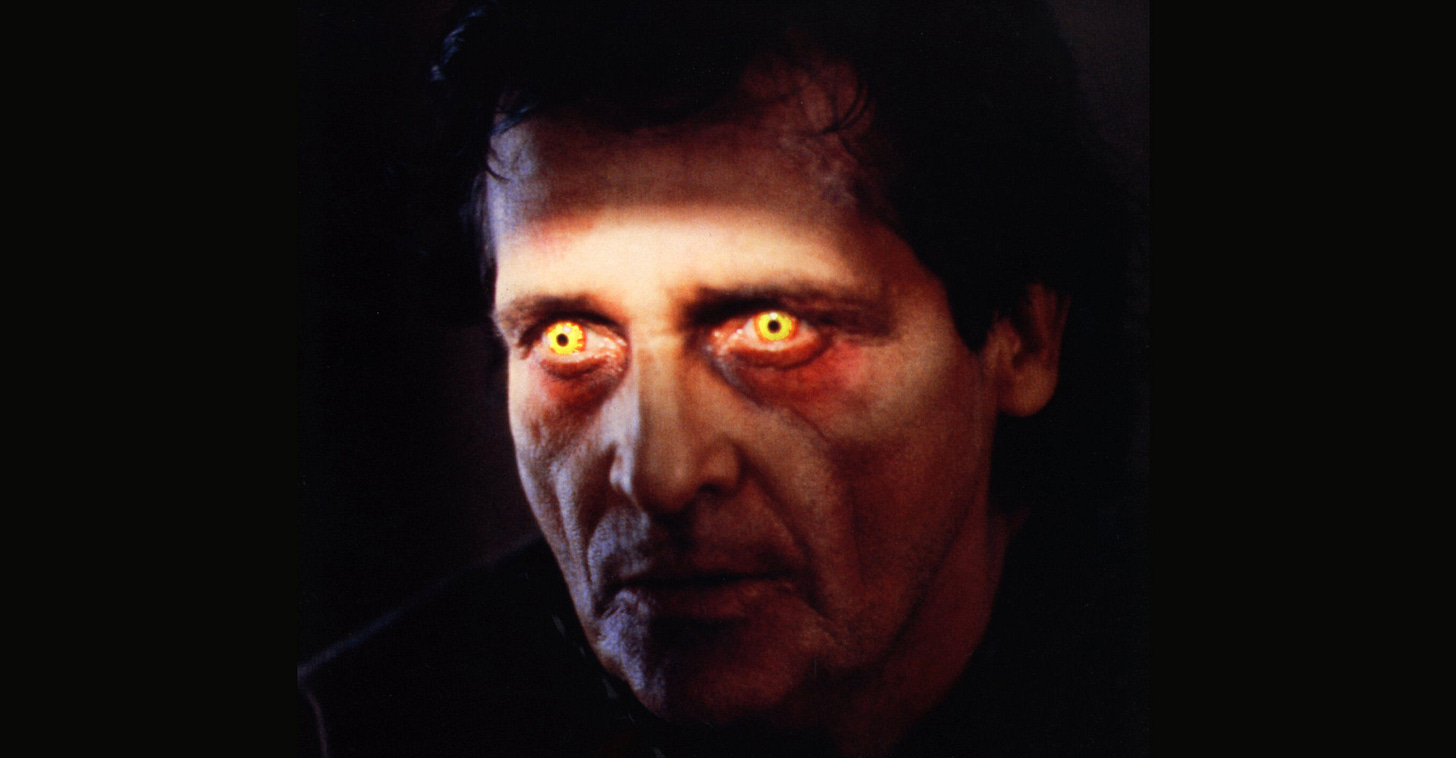9/10
If you’re going to make an Exorcist sequel at all, this is how you do it. That’s worth noting given the recent release of The Exorcist: Believer, which based on critical and audience reactions continues the tradition of Exorcist sequels sucking hard. Everything I’ve read about Believer suggests it’s another regurgitation of the classic first film, except this time with two possessed adolescent girls instead of one. On the opposite extreme, you have Exorcist II: The Heretic, which when I watched and reviewed it last year confirmed its reputation as one of the worst films ever made. Exorcist II admittedly tried something different, but was an abysmal failure.
The Exorcist III, written and directed by William Peter Blatty—author of the novel the first film is based on—is an adaptation of his novel Legion, which is a sequel to The Exorcist. This third instalment explores similar themes to the first Exorcist, but is a very different kind of film—emphasizing psychological horror and aspects of police procedurals. Blatty’s sequel follows a character from the first film, police detective Lt. William Kinderman (George C. Scott, replacing the late Lee J. Cobb), who investigates a series of grisly murders that match the modus operandi of the Gemini killer, a serial murderer inspired by the real-life Zodiac killer.
Like his late friend Father Damien Karras (Jason Miller), who died at the end of the first film to save the possessed Regan MacNeil—or did he?—Kinderman is struggling with his faith. Unlike Karras, we’re given no indication that Kinderman was ever that religious to begin with. But the subject comes up in part through his repeated friendships with Catholic priests. A dyed-in-the-wool film buff, Kinderman meets up each week with Fr. Joseph Dyer (Ed Flanders, replacing Fr. William O’Malley) to go to the movies. In the wake of a gruesome murder, Kinderman shares his skepticism over a God that would allow so much evil in the world, starting with death itself:
Kinderman: The whole world is a homicide victim, Father. Would a God who is good invent something like that [death]? Plainly speaking, it's a lousy idea. It's not popular. It's not a winner.
Fr. Dyer: There you go, blaming God.
Kinderman: Who should I blame? Phil Rizzuto?
Fr. Dyer: You wouldn't want to live forever.
Kinderman: Yes, I would.
Fr. Dyer: No, you wouldn't. You'd get bored.
Kinderman: I have hobbies. In the meantime, we have cancer and mongoloid babies and murderers, monsters prowling the planet, even prowling this neighborhood, Father... right now, while our children suffer... and our loved ones die, and your God goes waltzing blithely through the universe like some kind of cosmic Billie Burke.
Fr. Dyer: Bill, it all works out right.
Kinderman: When?
Fr. Dyer: At the end of time.
Kinderman: That soon?
Fr. Dyer: No. We're going to be there. We're going to live forever, Bill. We're spirits.
Kinderman: Oh, I would love to believe that.
The theme of God’s relevance in a modern, secular age is a recurring theme of the Exorcist series. Here Blatty examines the subject in greater detail than ever before. What Dyer is seeking an answer to is the problem of evil. Simply put: how can a God who is both all-good and all-powerful allow evil and suffering in the world?
Given the focus of the Exorcist series on Satan and demonic possession, it’s interesting to consider the belief systems of those who identify as Satanists, which tend to fall into two broad categories. On one side you have LaVeyan Satanism, an atheist philosophy developed by Anton LaVey which sees Satan as a metaphor for enlightenment, carnality, social non-conformity, and rebellion against the Abrahamic religions (Mötley Crüe bassist Nikki Sixx accurately described LaVeyan Satanism as “more of a personal philosophy with a shocking title than an actual religion”). On the other you have theistic Satanism, whose adherents worship Satan as an actual deity, supernatural entity, or spiritual being. The hosts of podcast Your Favorite Band Sucks, in their episode on cartoonishly Satanic thrash metal band Slayer, pointed out that anyone who professes adherence to Satanism of the latter variety implicitly accepts all the tenants of Christianity, or whatever faith they’re rebelling against.
While characters like Fr. Karras and Lt. Kinderman in the Exorcist series struggle with their Christian faith, through the story’s events they come to accept that Satan is real—a literal entity who can possess human beings, simply because no other explanation makes sense for what they’ve witnessed. Kinderman has trouble believing in God because he sees so much evil in the world, which is at odds with the notion of an all-good and all-powerful God. But as he faces off with a character possessed by a demon, perhaps even Satan himself, Kinderman yells out what he does believes in: “I believe in death,” he says. “I believe in disease. I believe in injustice and inhumanity, torture and anger and hate... I believe in murder. I believe in pain. I believe in cruelty and infidelity. I believe in slime and stink and every crawling, putrid thing... every possible ugliness and corruption, you son of a bitch. I believe... in you.” In a world filled with evil, darkness, suffering, and death, it may be easier for the spiritually inclined to believe in the devil rather than God. Yet one implies the existence of the other.
Fun fact: Blatty wanted Exorcist III to be titled Legion, but studio executives insisted on explicitly linking it to The Exorcist for commercial reasons, despite Blatty’s warnings. The director and screenwriter recalls:
I begged them when they were considering titles not to name it Exorcist anything -- because Exorcist II was a disaster beyond imagination. You can't call it Exorcist III, because people will shun the box office. But they went and named it Exorcist III. Then they called me after the third week when we were beginning to fade at the box office and they said 'We'll tell you the reason: it's gonna hurt, you're not gonna like this – the reason is Exorcist II'. I couldn't believe it! They had total amnesia about my warnings!
Studio interference also had a major impact on the film itself. Four months after Blatty completed principal photography, production company Morgan Creek insisted that a new ending be shot. According to Blatty, the secretary of Morgan Creek owner James Robinson said there had to be an exorcism in an Exorcist film—again, despite the fact that Blatty had wanted to discard Exorcist in the title altogether in favour of Legion. But he who pays the piper calls the tune. Blatty ended up directing reshoots that created a whole new character, Fr. Paul Morning (Nicol Williamson), who shows up at the climax to perform an exorcism.
I’m of two minds about this change. On the one hand, Morning is clearly shoehorned into the story and never interacts with any other character not possessed by a demon. On the other hand, when Morning starts performing the exorcism rite and throws holy water at the possessed, I felt like cheering. It’s like in a Batman film when Batman violently beats up a gang of hoodlums: this is what we associate with the character, and what the audience pays to see. I understand where execs were coming from, even if some cast and crew members bemoan the changes that were made. Brad Dourif, who plays James Venamun, aka the Gemini killer, has gone on record that “the original version was a hell of a lot purer and I liked it much more. As it stands now, it's a mediocre film. There are parts that have no right to be there.”
The exorcism scene does have a notable effect on the film’s content. Compared to The Exorcist, which reveled in shocking graphic imagery like the possessed Regan spewing pea-soup vomit, rotating her head 180 degrees, or masturbating with a crucifix, Exorcist III is restrained. There is a noticeable lack of blood and gore outside the exorcism during the climax. Instead, Blatty relies almost entirely on dialogue and the power of suggestion. Kinderman verbally describing the mutilation of the killer’s victims is just as effective as gory special effects would have been at detailing the stomach-churning results, if not more. There’s another scene where Kinderman discovers the body of a victim, and Scott conveys the horror of what he finds almost entirely through facial expressions and body movement. This is a film that remembers what horror writers and filmmakers from the Golden Age of Hollywood knew: sometimes what we imagine is scarier than anything that can be shown onscreen.
Exorcist III is often talky, in a way that betrays Blatty’s origins as a novelist, but never boring. There are many witty and funny lines. Much of the action takes place in a hospital, and there’s one memorable scene dominated by a single wide shot in which a nurse goes to check on strange sounds coming from a patient’s room. Blatty allows the scene to breathe, and gives plenty of time for the tension to build. I was surprised just how effective his direction was, given this was only the second film he directed. Jump scares are used sparingly. There are other scenes where it takes us a few seconds to register something horrifying happening on the screen, like a demon-possessed elderly patient crawling around on the ceiling.
At times the film’s talkiness goes a little too far: particularly prolonged scenes in which the Gemini killer speaks at great length about the circumstances regarding his own fate, demonic possession, and Fr. Karras. Dourif plays these scenes well, but it can’t help but feel like Blatty is committing the cardinal screenwriting sin of telling rather than showing. All this exposition underscores a central question: was it worth continuing the story of The Exorcist beyond the first film? The 1973 original is a classic that works perfectly as a standalone story, and arguably doesn’t need a sequel. The plot of this film makes you wonder why a supernatural being like Satan would bother throwing so much effort into revenge against particular humans.
Still, if you’re going to make an Exorcist sequel—a decision driven primarily by commercial rather than artistic considerations, and I don’t care who says otherwise—Blatty has done the best possible job here. The Exorcist III is an eerie, atmospheric film that manages to stand as a worthy follow-up to one of the greatest horror movies ever made, while carving out its own distinct identity. That’s an impressive balancing act. The MVPs are Blatty for his excellent writing and direction, and Scott for a fantastic performance. This is what an effective horror sequel looks like.









Well said!
'Exorcist III' should've been 'Exorcist II' as the immediate follow-up. None of that Pazuzu nonsense!